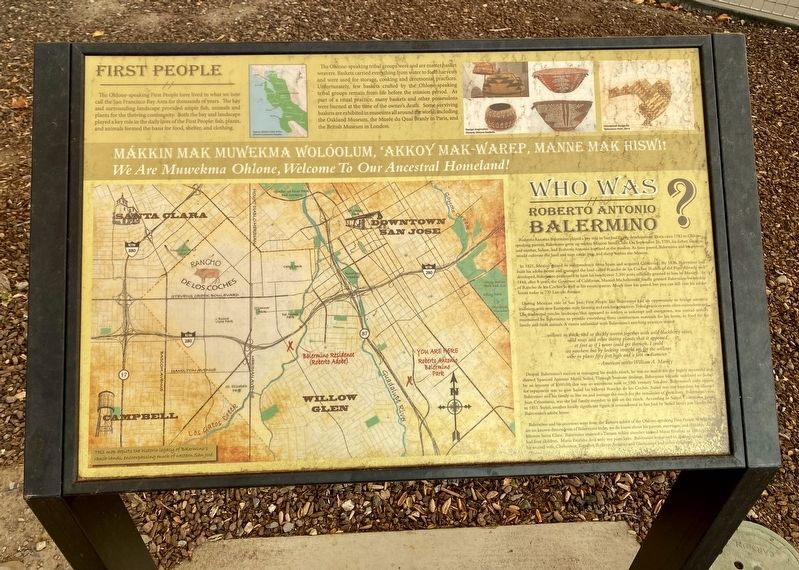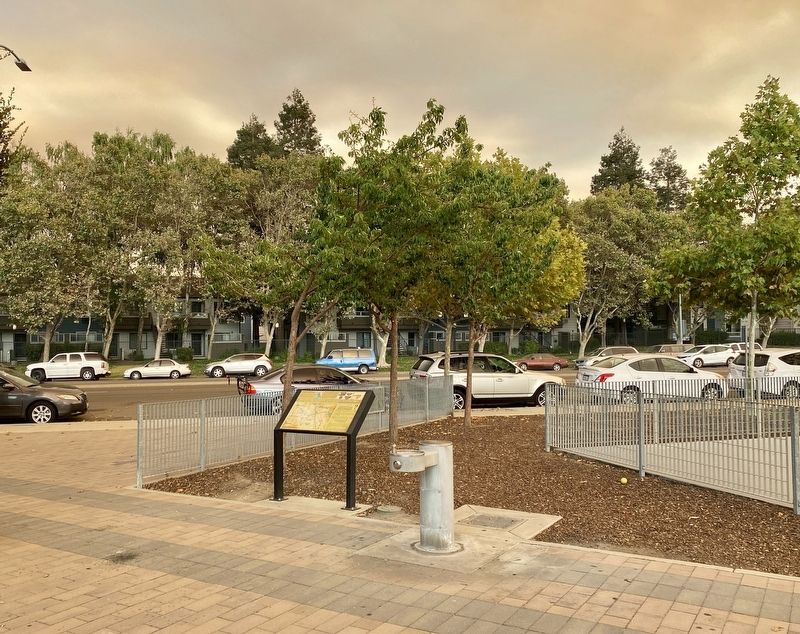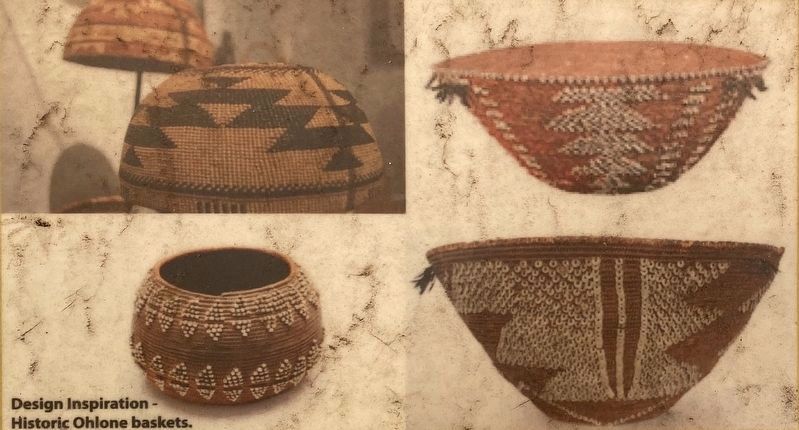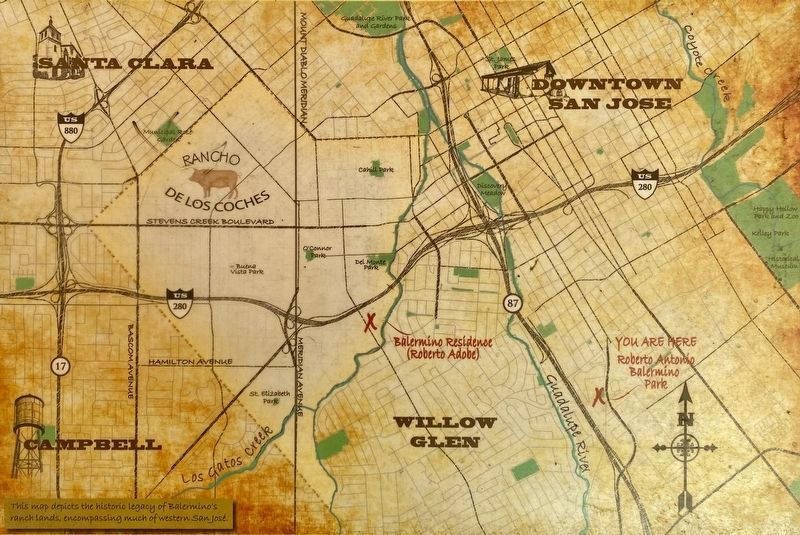Central San Jose in Santa Clara County, California — The American West (Pacific Coastal)
First People / Who Was Robert Antonio Balermino?
Inscription.
First People
The Ohlone-speaking First People have lived in what we now call the San Francisco Bay Area for thousands of years. The bay and surrounding landscape provided ample fish, animals and plants for the thriving community. Both the bay and landscape played a key role in the daily lives of the First People: fish, plants, and animals formed the basis for food, shelter, and clothing.
The Ohlone-speaking tribal groups were and are master basket weavers. Baskets carried everything from water to food harvests and were used for storage, cooking and ceremonial practices. Unfortunately, few baskets crafted by the Ohlone-speaking tribal groups remain from life before the mission period. As part of a ritual practice, many baskets and other possessions were burned at the time of the owner's death. Some surviving baskets are exhibited in museums all around the world, including the Oakland Museum, the Musée du Quai Branly in Paris, and the British Museum in London.
Mákkin mak muwekma wolóolum, akkoy mak-warep, manne mak hiswi!
We Are Muwekma Ohlone, Welcome To Our Ancestral Homeland!
Who was Roberto Antonio Balermino?
Roberto Antonio Balermino played a key role in San José's early development. Born circa 1782 to Ohlone-speaking parents, Balermino grew up within Mission Santa Clara. On September 26, 1785, his father, Guascai, and mother, Sulum, had Roberto Antonio baptized at the mission. As time passed, Balermino and his parents would cultivate the land and raise cattle, pigs, and sheep within the Mission.
In 1821, Mexico gained its independence from Spain and acquired California By 1836, Balermino had built his adobe home and managed the land called Rancho de los Coches (Ranch of the Pigs). Already well developed, Balermino petitioned to have his ranch, over 2,200 acres, officially granted to him by Mexico. In 1844, after 8 years, the Governor of California, Manuel Micheltorena, finally granted Balermino ownership of Rancho de los Coches as well as his emancipation. Much time has passed, but you can still visit his adobe home today at 770 Lincoln Avenue.
During Mexican rule of San José, First People like Balermino had an opportunity to bridge ancestral traditions with new European-style farming and ranching practices. Tribal practices were often misunderstood. The traditional rancho landscape, that appeared to settlers as unkempt and overgrown, was instead artfully maintained by Balermino to provide everything from construction materials for his home, to food for his family and farm animals. A visitor unfamiliar with Balermino's ranching practices wrote,
...willows so thick, and so thickly woven
together
with wild blackberry vines,
wild roses and other thorny plants, that it appeared
at first as if I never could get through. I could
see nowhere but by looking straight up, for the willows
were in places fifty feet high and a foot in diameter."
- American settler William A. Manley
Despite Balermino's success at managing his sizable ranch, he was no match for the highly successful and shrewd Spaniard Antonio María Suñol. Through business dealings, Balermino became indebted to Suñol by an amount of $500.00; this was an enormous sum in 19th century San José. Balermino's only option for repayment was to give Suñol his beloved Rancho de los Coches. Suñol was not heartless; he allowed Balermino and his family to live on and manage the ranch for the remainder of their lives. Balermino's son, Juan Crisostoma, was the last family member to live on the ranch. According to Suñol, Crisostoma passed in 1851. Suñol, another locally significant figure, is remembered in San José by Suñol Street just blocks from Balermino's adobe home.
Balermino and his ancestors were from the Tamien triblet of the Ohlone-speaking First People, While there are no known descendents of Balermino today, we do know about his parents, marriages, and children. At the Mission Santa Clara; Balermino married a Tamien triblet member named Maria Estafana in 1801 and had four children. Maria Estafana died only ten years later. Balermino remarried in approximately [illegible] his second wife, Chebuunot. Together, Roberto Antonio and Chebuunot had seven children.
Topics. This historical marker is listed in these topic lists: Native Americans • Settlements & Settlers. A significant historical date for this entry is September 26, 1785.
Location. 37° 18.557′ N, 121° 52.736′ W. Marker is in San Jose, California, in Santa Clara County. It is in Central San Jose. Marker is on Almaden Road, on the right when traveling south. Touch for map. Marker is at or near this postal address: 1555 Almaden Road, San Jose CA 95125, United States of America. Touch for directions.
Other nearby markers. At least 8 other markers are within 2 miles of this marker, measured as the crow flies. Willow Glen Public Buildings (approx. 1.1 miles away); Willow Glen Schools (approx. 1.1 miles away); Charles Henry McKiernan (approx. 1.1 miles away); Buffington House (approx. 1.2 miles away); Margaret Caldwell Fox (approx. 1.3 miles away); National Gratitude (approx. 1.3 miles away); Exodus and Entry (approx. 1.3 miles away); Lee's Sandwiches (approx. 1.3 miles away). Touch for a list and map of all markers in San Jose.
More about this marker. The marker is located a few steps in from the entrance to Robert Antonio Balermino Park
Related marker. Click here for another marker that is related to this marker.
Also see . . .
1. Native Americans in the Rancho Era: Roberto-Suñol and Olompali (The California Frontier Project). (Submitted on August 23, 2020.)
2. Rancho De Los Coches (California Ranchos). (Submitted on August 23, 2020.)
Credits. This page was last revised on February 7, 2023. It was originally submitted on August 23, 2020, by Andrew Ruppenstein of Lamorinda, California. This page has been viewed 273 times since then and 37 times this year. Photos: 1, 2, 3, 4. submitted on August 23, 2020, by Andrew Ruppenstein of Lamorinda, California.



